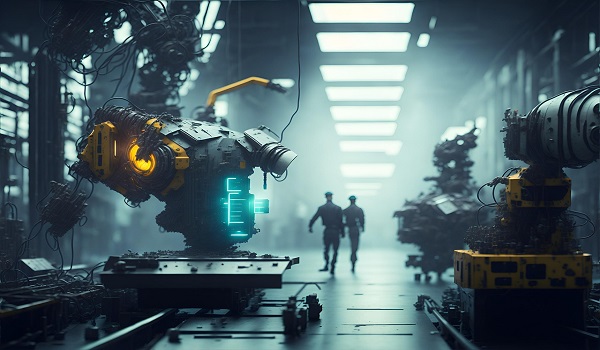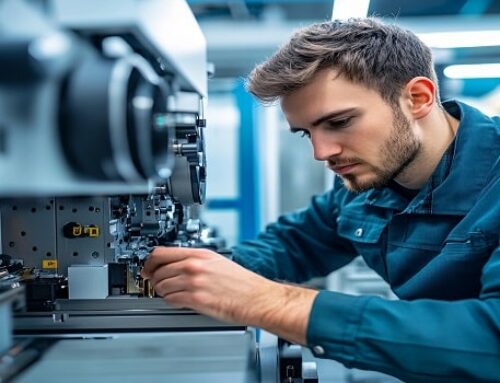Did you know that 645,000 workplace accidents occur annually in France, with 15% involving industrial machines? Industrial machine safety today represents a major strategic challenge for all manufacturing companies. Faced with rapid technological evolution and increasing regulatory requirements, how can you ensure optimal protection for your operators? Industrial machine safety encompasses all measures, equipment, and procedures aimed at preventing accidents during the use of industrial equipment. This crucial discipline combines technical expertise, regulatory compliance, and continuous team training. Indeed, investing in machine safety means protecting your human capital while preserving operational performance.

Key Points to Remember About Industrial Machine Safety:
- Strict regulation: Machinery Directive 2006/42/EC and ISO 12100 standards mandatory
- High costs: An accident costs an average of €150,000 to the company
- Active prevention: Risk assessment and continuous training essential
- Appropriate equipment: Protective devices and emergency stops mandatory
- Digitalization: Digital instructions to reduce human errors by 40%
Would you like to deepen your knowledge?
Contact our experts now for a personalized consultation on your safety approach.
1. Why is industrial machine safety crucial today?
Industrial machine safety constitutes a fundamental pillar of modern industrial performance. Accelerated technological evolution, combined with increasingly strict regulatory requirements, imposes constant vigilance on companies.
Consequently, understanding current challenges becomes essential for any industrial organization.
1.1. What are the main risks for operators?
Risks related to industrial machines are classified into several distinct categories:
- Mechanical risks: Crushing, cutting, entanglement by moving parts
- Thermal risks: Burns from contact with hot or cold surfaces
- Electrical risks: Electrocution, electric arc, short circuit
- Chemical risks: Exposure to hazardous substances during maintenance
- Ergonomic risks: Musculoskeletal disorders related to postures
- Psychosocial risks: Stress, cognitive fatigue when facing complex machines
Nevertheless, these risks can be considerably reduced through a structured and preventive approach.
1.2. What are the consequences of an accident for the company?
An industrial accident generates multiple and lasting impacts:
Direct costs:
- Medical expenses and compensations
- Production downtime
- Equipment repairs and replacements
- Administrative and legal costs
Indirect costs:
- Loss of team productivity
- Deterioration of social climate
- Impact on brand image
- Increase in insurance premiums
Furthermore, human consequences remain irreversible and constitute the primary concern.
1.3. How does regulation frame machine safety?
The European regulatory framework imposes strict obligations:
Machinery Directive 2006/42/EC:
- Mandatory CE marking for all machines
- Manufacturer’s declaration of conformity
- Instruction manual in French
- Compliance with essential safety requirements
Applicable technical standards:
- ISO 12100: General design principles
- ISO 14119: Interlocking devices
- ISO 13849: Safety of control systems
Moreover, the French Labor Code reinforces these requirements with specific obligations for employers.
2. How to implement an effective safety approach?
Industrial machine safety requires a methodical and structured approach. Indeed, an effective approach relies on three fundamental pillars: risk assessment, implementation of appropriate equipment, and continuous team training.
This comprehensive approach ensures optimal protection while maintaining operational performance.
2.1. What are the key steps in risk assessment?
Risk assessment follows a rigorous 5-step methodology:
- Hazard identification:
- Analysis of machines and workstations
- Inventory of dangerous phenomena
- Mapping of risk zones
- Exposure assessment:
- Operator exposure frequency
- Intervention duration
- Normal and abnormal use conditions
- Risk estimation:
- Probability of occurrence
- Severity of potential damage
- Criticality matrix
- Action prioritization:
- Prioritization according to risk level
- Definition of deadlines
- Resource allocation
- Implementation and monitoring:
- Deployment of preventive measures
- Effectiveness control
- Periodic review
2.2. What protective equipment should be prioritized?
Operator protection relies on a combination of complementary equipment:
Collective protection devices:
- Fixed and movable guards
- Photoelectric barriers
- Pressure-sensitive mats
- Emergency stop systems
Personal protective equipment:
- Safety helmets and glasses
- Gloves adapted to risks
- Safety shoes
- High-visibility clothing
Functional safety systems:
- Two-hand controls
- Validation devices
- Redundant systems
- Periodic self-checks
However, selection must take into account operational and ergonomic constraints.
2.3. How to train and raise awareness among teams?
Training constitutes the foundation of any successful safety approach:
Initial training:
- Safety induction for new arrivals
- Specific certifications per machine
- Emergency and evacuation procedures
- Use of protective equipment
Continuous training:
- Periodic skills refresher
- Regulatory updates
- Incident feedback
- New technologies and developments
Daily awareness:
- Safety talks
- Posting and signage
- Field audits
- Recognition of good practices
Ultimately, the commitment of all hierarchical levels remains decisive for success.
3. What is the solution for digitalizing your safety procedures?
Industrial machine safety is experiencing an unprecedented digital revolution. From now on, companies can rely on innovative digital solutions to transform their safety procedures.
This digital transformation offers unprecedented opportunities to improve safety performance while simplifying operational management.

3.1. Why go digital for machine safety?
Digital technology revolutionizes machine safety management with tangible benefits:
Reduction of human errors:
- Visual and interactive instructions
- Step-by-step operator guidance
- Automatic alerts in case of non-compliance
- Complete traceability of actions
Improved reactivity:
- Instant procedure updates
- Immediate dissemination of critical information
- Real-time anomaly reporting
- Rapid support team intervention
Cost optimization:
- 40% reduction in accidents
- Decreased downtime
- Savings on paper printing
- Increased training efficiency
Access to exploitable data:
- Real-time dashboards
- Predictive analytics
- Trend identification
- Performance-driven management
3.2. How does Picomto revolutionize safety instruction management?
Picomto radically transforms the approach to industrial machine safety:
Interactive digital instructions:
- Step-by-step visual procedures
- Explanatory videos and animations
- Integrated compliance controls
- Adaptation to operator level
Centralized management:
- Single procedure library
- Automatic versioning
- Personalized access rights
- Multi-site synchronization
Monitoring and traceability:
- Complete action history
- Task completion times
- Difficulty identification
- Regulatory compliance evidence
System integration:
- Connection to existing ERPs
- CMMS interface
- IoT compatibility
- Open APIs
Mobility and ergonomics:
- Tablets and smartphones
- RealWear connected glasses
- Intuitive interface
- Offline operation
4. How to continuously optimize your machine safety?
Industrial machine safety cannot be conceived without a continuous improvement approach. Indeed, permanent optimization of safety devices ensures increasingly effective operator protection. This dynamic approach relies on monitoring relevant indicators, intelligent exploitation of field data, and an improvement culture shared by all.
4.1. What indicators should be monitored?
Machine safety management relies on key performance indicators:
Result indicators:
- Accident frequency rate (AFR)
- Accident severity rate (ASR)
- Number of incidents per machine
- Accident cost
Means indicators:
- Personnel training rate
- Number of safety audits conducted
- Percentage of corrected non-conformities
- Safety investment per machine
Predictive indicators:
- Number of near-misses reported
- Protective equipment wear rate
- Preventive maintenance frequency
- Team engagement level
Operational indicators:
- Downtime for safety maintenance
- Anomaly processing time
- Equipment availability rate
- Training performance
Consequently, these indicators enable precise management and informed decision-making.
4.2. How to exploit field data?
Field data exploitation constitutes a powerful improvement lever:
Automated collection:
- IoT sensors on machines
- Mobile application feedback
- Video surveillance systems
- Anomaly detectors
Predictive analysis:
- Machine learning algorithms
- Weak signal detection
- Failure prediction
- Maintenance optimization
Real-time dashboards:
- Safety KPI visualization
- Automatic alerts
- Risk mapping
- Inter-site benchmarking
Artificial intelligence:
- Image recognition
- Behavioral detection
- Personalized recommendations
- Procedure optimization
4.3. What place for continuous improvement?
Continuous improvement structures the long-term safety approach:
Applied PDCA cycle:
- Plan: Identification of improvement areas
- Do: Action implementation
- Check: Result control
- Act: Standardization and deployment
Team participation:
- Digital suggestion boxes
- Safety working groups
- Structured experience feedback
- Good practice recognition
Technological watch:
- Regulatory developments
- Technological innovations
- Sectoral benchmarking
- Research partnerships
Knowledge capitalization:
- Shared knowledge base
- Adapted training
- Updated procedures
- Reinforced safety culture
Finally, this dynamic approach ensures continuous organizational skill development.
Conclusion
Industrial machine safety represents a complex challenge that requires a comprehensive and evolving approach. This synthesis highlights the three fundamental pillars: regulatory compliance, risk management, and digital transformation.
The harmonious integration of these dimensions allows achieving optimal safety levels while preserving operational performance. In a context of accelerated technological evolution, companies that invest in innovative digital solutions gain a competitive advantage. Industrial machine safety is no longer just a regulatory constraint but becomes a true lever for competitiveness and operational excellence.
Ready to transform your industrial safety?
Request a Picomto demonstration and discover how to effectively digitalize your safety processes.
FAQ
What are the main safety standards for industrial machines?
The Machinery Directive 2006/42/EC and the EN ISO 12100 standard constitute the fundamental references.
What is machine safety?
The set of technical and organizational measures aimed at eliminating or reducing risks.
What are examples of machine safety?
Fixed guards, emergency stop devices, interlocking systems, operator training.
What are the legal obligations regarding machine safety?
CE marking, risk assessment, personnel training, mandatory preventive maintenance.
What are the 4 safety rules?
Elimination, prevention, collective protection, individual protection according to the hierarchy of measures.
What are the 4 safety criteria?
Reliability, availability, integrity, and confidentiality of industrial safety systems.






Leave A Comment